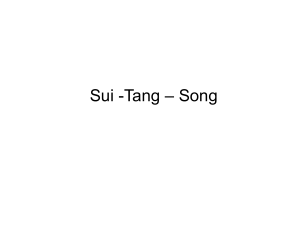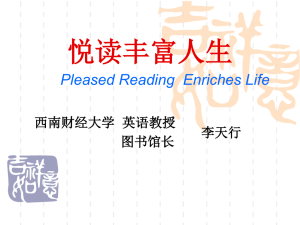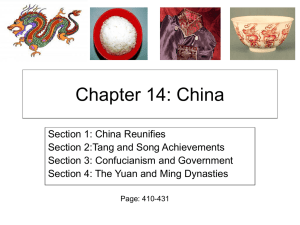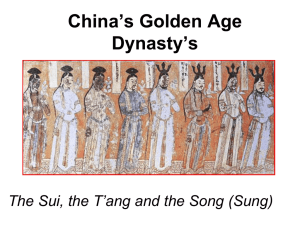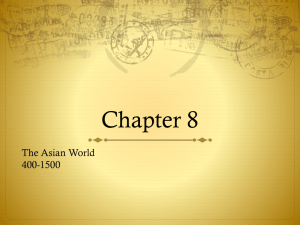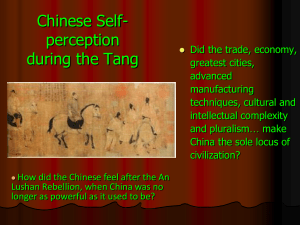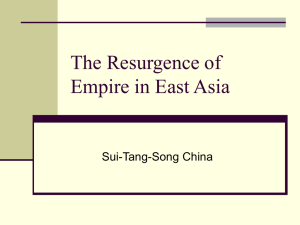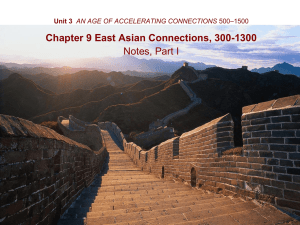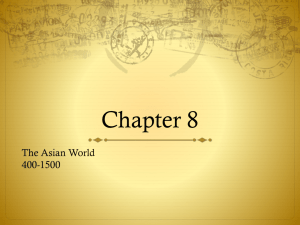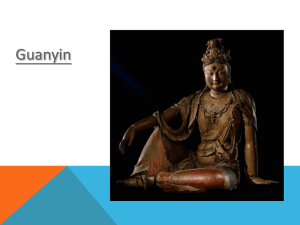apart2014.sui tang and song dynasties
advertisement
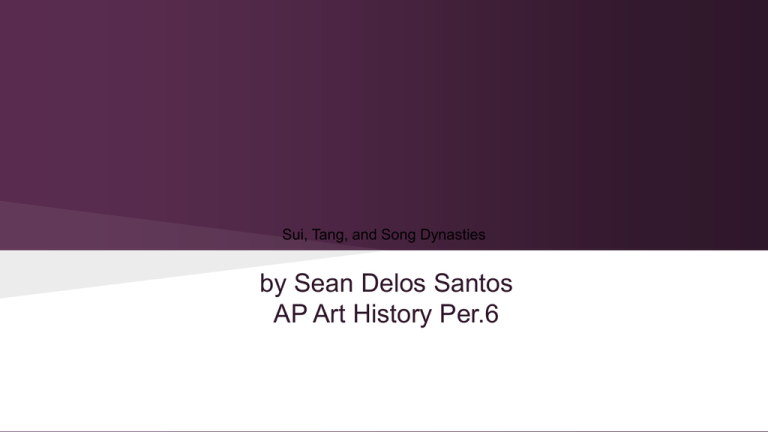
Sui, Tang, and Song Dynasties by Sean Delos Santos AP Art History Per.6 Sui and Tang Dynasties • • • The Sui Dynasty reigned from 581 CE to 618 CE. It was modeled on the Han Dynasty. Buddhism diffused into Chinese society. 10-13. Seated Buddha, Cave 20, Yungang, Datong, Shanxi. Northern Wei dynasty, c. 460 CE. Stone, height 45’ (13.7 m)This image doesn’t belong in this ppt 10-14. Altar to Amitabha Buddha. Sui dynasty, 593 CE. Bronze, height 30 ⅛” (76.5 cm). Museum of Fine Arts, Boston. Amitabha Buddha • • • Mahayana Buddhism was the most popular form of Buddhism in China and Japan. It believed in the “Pure Land” where faithful followers were reborn Who is Amitabha Budda? • writing is very small throughout ppt Amitabha Buddha • • • • Jewels on leaves 7 nymphs on clusters Pearls on tree trunks Halo of flames Amitabha Buddha • • • • Bodhisattva Guanyin with pomegranate Bodhisattva in prayer Incense burner Tell us what a bodhisattva is Amitabha Buddha • • • • Seated dogs 2 smaller bodhisattvas Combines Indian, Central Asian, and Chinese styles describe these styles! Sui and Tang Dynasties • • • The Tang Dynasty reigned from 618 CE to 917 CE. The Tang may be described as “strong, vigorous, noble, idealistic, realistic, and pragmatic.” one of the greatest dynasties in Chinese History Sui and Tang Dynasties • • • The Tang Dynasty capital was Chang’an. They controlled Central Asia and influenced Japanese and Korean culture. They entered a profitable trade system along the South China Sea with the Arabs and Persians. 10-15. Camel Carrying a Group of Musicians, from a tomb near Xi’an, Shanxi. Tang dynasty, c. mid-8th century CE. Earthenware with three-color glaze, height 26 ⅛” (66.5 cm). Museum of Chinese History, Beijing. Camel Carrying a Group of Musicians • • • • Displays Turkish influence The three bearded musicians are Central Asian. The two smooth-shaven people are Han Chinese. Tang were fascinated with the exotic Turkic culturs of central Asia Camel Carrying a Group of Musicians • • • The two-humped Bactrian camels were widely used along the Silk Road. People on camelback was a popular Tang motif. Naturalism (liveliness and motion) was also popular. • musicians on camelback were a popular Tang motif Camel Carrying a Group of Musicians • • • • • Tang sculptures often had a three-color glaze. These three colors were often chosen from amber, yellow, green, and white glaze tecnique a specialty of Tang ceramicists describe process, which gave feeling of spontaneity thousands of ceramic figurines produced for Tang tombs Buddhist Art and Architecture • • Buddhism had been widely accepted throughout all of China.-greatest development during Tang dynasty Mahayana Buddhism (also known as the Pure Land Sect) was the most popular of the Buddhist sects. Buddhist Art and Architecture • • • • Located in Dunhuang were 500 caves that held Buddhist artifacts. These Buddhist artifacts included painted clay sculptures and wall paintings. The caves were made from the 5th to the 14th century. rare exxtended jperiod of stylistic and iconographic evoluton in one place Buddhist Art and Architecture • • The Seated Buddha was found in Cave 20 of the 500 caves. but pre-Tang era 10-16. The Western Paradise of Amitabha Buddha, detail of a wall painting in Cave 217, Dunhuang, Gansu. Tang dynasty, c. 750 CE. 10’2” x 16’ (3.1 x 4.86 m). The Western Paradise of Amitabha Buddha • • The Amitabha Buddha is surrounded by 4 bodhisattvas. There are more bodhisattvas to the left and to the right. blow up details so we can see what you are talking about The Western Paradise of Amitabha Buddha • • • • • Musicians and dancers are performing in the foreground. There are great halls and towers in the background. the artist has imagined the WEstern Paraise in terms of the grandeur of Tang palaces; a worldly vision of paradise big conrast with earlier Sui altarpiece shows us splenor of Tang civilzation when Chang’an was probably the greatest city in the world The Western Paradise of Amitabha Buddha • • Many people believe this area represents Chang’an, the Tang Dynasty’s capital. Naturalism can be seen all throughout the wall painting. Sui and Tang Dynasty • • China had followed the idea of religious tolerance for many years. However, as Confucians gradually rose in influence, China turned to a more conservative way of thinking.in 9th century Sui and Tang Dynasty • • Buddhism was then seen as a foreign religion. The Chinese destroyed countless Buddhist temples, shrines, monasteries, and statues. 10-17. Nanchan Temple, Wutaishan, Shanxi. Tang dynasty, 782 CE. Nanchan Temple • • The Nanchan Temple displays a curved tiled roof, which is reminiscent of the Han tomb model of a house. one of the few structures earlier than 1400 to have survived Han Tomb Model of a House Nanchan Temple • • The temple has a bay, a structural element made of four posts and their lintels. The bay became a module (a basic structural unit) for later buildings. Nanchan Temple • • Larger structures were made with repeating patterns of bays Nanchan only has 3 bays. 10-18. Great Wild Goose Pagoda at Ci’en Temple, Xi’an, Shanxi. Tang dynasty, first erected 645 CE; rebuilt mid-8th century CE. Great Wild Goose Pagoda • • The Great Wild Goose Pagoda was made in honor of Xuanzang after his 16-year pilgrimage to India. The pagoda originated from the Indian stupa which holds relics. Indian Stupa Great Wild Goose Pagoda • • • The pagoda resembles a Han watchtower.In China, the stupa blended with the Han watchtower to produce the pagoda It features low relief bays and bracket systems. The pagoda is made of masonry but was made to resemble wood. Great Wild Goose Pagoda • • The pagoda was originally five stories but two more stories along with a finial were constructed. The pagoda emphasizes the Tang beliefs of simplicity, symmetry, proportion, and grace. Figure Painting • • There are very few pieces of Tang art that feature figure painting. However, the Dunhuang painting gives a good idea of what it looked like.--discussed earlier, slide 10-16 The Western Paradise of Amitabha Buddha unnecessary--delete Figure Painting • • The Song Dynasty was greatly influenced by the Tang Dynasty. The Song Dynasty borrowed many artistic styles from the Tang Dynasty. 10-19. Attributed to Emperor Huizong. Detail of Ladies Preparing Newly Woven Silk, copy after a lost Tang dynasty painting by Zhang Xuan. Northern Song dynasty, early 12th century CE. Handscroll, ink and colors on silk, 14 ½ x 57 ½” (36 x 145.2 cm). Museum of Fine Arts, Boston. Women Preparing Newly Woven Silk • The painting contains several sections, each depicting women weaving or ironing silk. Women Preparing Newly Woven Silk • The original painting by Zhang Xuan, a famous Tang painter of women at the court, was lost. Women Preparing Newly Woven Silk • • • A Song copy of Zhang Xuan’s work was made. This is evident from several inscriptions on the painting itself missing some formal analysis Song Dynasty • • • • The Song Dynasty reigned from 960 CE to 1279 CE. Its capital was located at Bianjing near the Yellow River. In 1126, Northern China was conquered by the Jurchen tribes from Manchuria. This caused the unconquered part of China now known as Southern Songto enter a period of introspection and reflection. Song Dynasty • • While Northern Song lasted from 960 CE to 1126 CE, Southern Song continued on from 1127 CE to 1279 CE with a capital at Hangzhou. The Song Dynasty borrowed from the agricultural, commercial, and technological advancements of the Tang Dynasty. Song Dynasty • Although the Song Dynasty had a dark past, its artworks maintained the ideas of grace and simplicity. • where is slide and info from box “Elements of Architecture” on p.377 10-20. Seated Guanyin Bodhisattva. Liao dynasty, 10th-12th century. Wood with paint and gold, 95 x 65” (241.3 x 165.1 cm). The Nelson Atkins Museum of Art, Kansas City, Missouri. Seated Guanyin Bodhisattva • • A bodhisattva was a Buddhist who had already reached enlightenment but stayed behind to help others. They were depicted as princes with royal garments and jewelry. Seated Guanyin Bodhisattva • • Guanyin was the bodhisattva of infinite compassion. He appears in many forms such as the Water or Moon Guanyin. Seated Guanyin Bodhisattva • • • Guanyin is seen in the royal ease, a pose characterized by the following: A bent right knee with the right arm resting on top A hanging left leg and arm with the foot atop a lotus blossom Seated Guanyin Bodhisattva • The original sculpture was made in the 11th or 12th century but was painted and gilded in the 16th century. Song Dynasty • • • The Song Dynasty was known for its “intellectual” art style. Unlike the Tang Dynasty, the Song Dynasty contained artworks that were mostly, if not purely, Chinese. It was known for its brilliant scholars, poetry, painting, and ceramics. Philosophy: Neo-Confucianism • • Neo-Confucianism was a syncretic blend of Confucianism, Buddhism, and Daoism. Buddhism and Daoism gave Neo-Confucianism the metaphysical explanation of the universe that Confucianism lacked. Philosophy: Neo-Confucianism • • • Neo-Confucianism believed in the li (principle or idea) and the qi (matter). All li are part of the Great Ultimate and the qi must be purified through education and selfcultivation to accomplish the li’s goal. This goal takes a lifetime and the end result is enlightenment, a concept from Buddhism. Northern Song Painting • • • • The Song Dynasty often painted landscapes with ample amounts of detail. The Chinese during the Song Dynasty believed that mastering the form of an object grants you one step closer to understanding it. Landscapes represented the emotions of the artist. missing info Northern Song Painting • The artistic shift from humans to landscapes mirrors the shift from religion to philosophy and aesthetics. 10-21. Fan Kuan. Travelers among Mountains and Streams. Northern Song dynasty, early 11th century CE. Hanging scroll, ink and colors on silk, height 6’9 ½” (2.06 m). National Palace Museum, Taipei, Taiwan. Travelers among Mountains and Streams • • • Fan Kuan (990 CE - 1030 CE) Resembles a drama--in 3 stages The rocks in the foreground represent the beginning and main theme. Travelers among Mountains and Streams • • The travelers’ size show the vastness of nature. The middle of the painting is dynamic and represents the progression of the story. Travelers among Mountains and Streams • • The mountain’s size represents the struggle in reaching the Great Ultimate. The mist hides the transition between the middle and the mountains, symbolizing confusion. Travelers among Mountains and Streams • Jagged and staccato (raindrop texture in Chinese) strokes accurately show the rocks’ textures. Travelers among Mountains and Streams • The large central peak surrounded by lesser peaks may represent hierarchy of scale with the Buddha and his bodhisattvas or the emperor and his officials. Travelers among Mountains and Streams • • Natural landscape represents Daoist ideals ability of Chinese landscape painters to take us out of ourselves and let us wanser freely through their sites is closely linked to hte avoidance of perspectie as understood int eh west. Goal of Chinese painting is precisely to get away froom such limits and show a totality beyond what we are normally given to see 10-22. Xu Daoning. Detail of Fishing in a Mountain Stream. Northern Song dynasty, mid-11th century CE. Handscroll, ink on silk, 19” x 6’10” (48.9cm x 2.09 m). The Nelson-Atkins Museum of Art, Kansas City, Missouri. Fishing in a Mountain Stream • • Unlike Western art, Chinese handscrolls can show constantly changing viewpoints. 7’ long by Xu Daoning (970 CE - 1052 CE) Fishing in a Mountain Stream • • The eye may lead into the background or move left through the painting. The travelers go through a journey, meet new people, and join nature. Fishing in a Mountain Stream • • The mountains echo from the center. Handscrolls are like Western Music in that you cannot experience their content all at once. 10-23. Zhang Zeduan. Detail of Spring Festival on the River. Northern Song dynasty, early 12th century CE. Handscroll, ink and colors on silk, 9 ½” x 7’4” (24.8 x 2.28 m). The Palace Museum, Beijing. Spring Festival on the River • • • • Depicts daily life Boats are coming in from the Grand Canal. There are stores and markets on the bridge. The bridge is bustling with people. Spring Festival on the River • • Everything is moving. Zhang Zeduan was a scholarly-official. Spring Festival on the River • The views of art during his time were shifting away from skill so this work was never made popular until the 20th century. Southern Song Painting and Ceramics 10-24. Xia Gui. Detail of Twelve Views from a Thatched Hut. Southern Song dynasty, early 13th century CE. Handscroll, ink on silk, height 11” (28 cm), length of extant portion 7’7 ½” (2.31 m). The Nelson-Atkins Museum of Art, Kansas City, Missouri. Twelve Views from a Thatched Hut • • Xia Gui (1180 CE - 1230 CE) was a member of the Academy of Painters. However, he created his own artistic style. Twelve Views from a Thatched Hut • • Unlike the Northern Song’s large, majestic figures, the Southern Song uses techniques that make everything look blended together. missing info on southern song focus compared with northern song focus Twelve Views from a Thatched Hut • • The mists that flow across the painting seem like a glimpse of a heavenly world. The painting invokes introspection and a longing to explore the unknown. Twelve Views from a Thatched Hut • The rationality and intellectual factor of art shifted to an emotional factor. Twelve Views from a Thatched Hut • The Neo-Confucianism “School of the Mind” teaches contemplation to reach enlightenment. This resembles Chan (Zen in Japan) Buddhism. 10-25. Guan ware vase. Southern Song dynasty, 13th century CE. Porcelaneous stoneware with crackled glaze, height 6 ⅝” (16.8 cm). Percival David Foundation of Chinese Art, London. Guan Ware Vase • • • Song pottery serves as the model for excellence around the world. They show simplicity and are much different from the extravagant Tang artworks. Tell us about Guan ware Guan Ware Vase • • • The outward lip, long neck, and round shape give the vase a sense of harmony. The white glaze represents space just like the Twelve Views from a Thatched Hut. what about the crackle technique? Southern Song Dynasty • • In 1279, the Southern Song Dynasty fell to Kublai Khan (1215 CE - 1294 CE). Kublai Khan was the leader of the Mongol empire and they conquered the Song Dynasty to establish the Yuan Dynasty.

